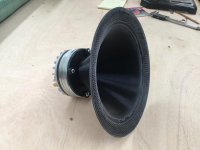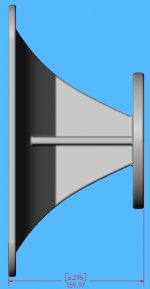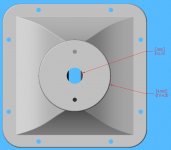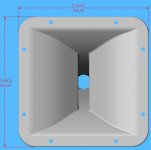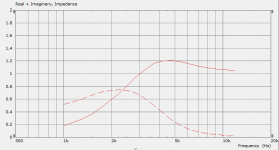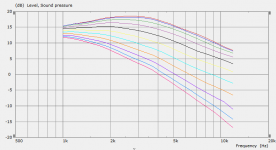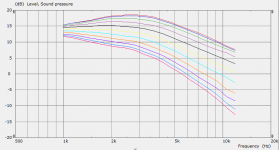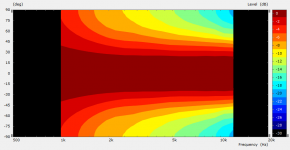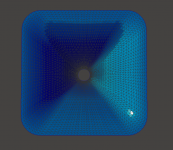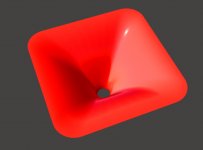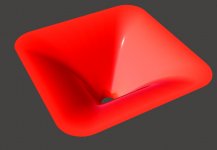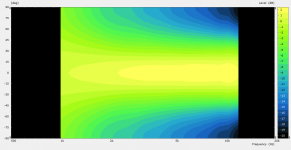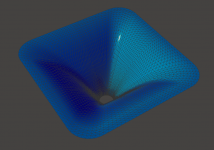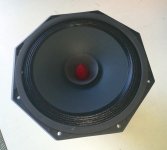You'd have to give me an example, but at any rate it never happens in acoustics.
..um, rate-*dependent Hysteresis?
*which is still Hysteresis.
..can't think of any rate-independent or "permanence" effects for acoustics though. Surely there must have been a Monty Python script about an infinite echo though..
I'm afraid you would have to call anything with an impulse response longer than an infinitely short duration to have a "hysteresis", i.e. the ability to "remember" its history beyond input stimulus. I'm only not sure that would be very meaningfull. In this sense the horn really does "remember" that e.g. an impulse was sent before because it takes some for the sound waves to leave the horn - can be bouncing around for a while. 
Hysteresis - Wikipedia
"Hysteresis can be a dynamic lag between an input and an output that disappears if the input is varied more slowly; this is known as rate-dependent hysteresis. However, phenomena such as the magnetic hysteresis loops are mainly rate-independent, which makes a durable memory possible."
"Hysteresis can be a dynamic lag between an input and an output that disappears if the input is varied more slowly; this is known as rate-dependent hysteresis. However, phenomena such as the magnetic hysteresis loops are mainly rate-independent, which makes a durable memory possible."
Hysteresis - Wikipedia
"Hysteresis can be a dynamic lag between an input and an output that disappears if the input is varied more slowly; this is known as rate-dependent hysteresis.
This makes it a nonlinear phenomena and horns and waveguides are linear devices.
This tool is of tremendous help to me. Thanks for making it available!
Will future iterations allow for different curves? Horn exits projected onto a curved surface?
Below is my mockup of a 9.6" waveguide on my radian 760neo, fresh off the printer after I knocked down the support a little.
Will future iterations allow for different curves? Horn exits projected onto a curved surface?
Below is my mockup of a 9.6" waveguide on my radian 760neo, fresh off the printer after I knocked down the support a little.
Attachments
Last edited:
Hysteresis - Wikipedia
"One type of hysteresis is a lag between input and output. An example is a sinusoidal input X(t) that results in a sinusoidal output Y(t), but with a phase lag φ... Such behavior can occur in linear systems... it is mathematically equivalent to a transfer function in linear filter theory and analogue signal processing."
I just don't get why would anyone want to talk about that as of hysteresis. I have never seen the term used like that.
"One type of hysteresis is a lag between input and output. An example is a sinusoidal input X(t) that results in a sinusoidal output Y(t), but with a phase lag φ... Such behavior can occur in linear systems... it is mathematically equivalent to a transfer function in linear filter theory and analogue signal processing."
I just don't get why would anyone want to talk about that as of hysteresis. I have never seen the term used like that.
Last edited:
What do you mean by different curves?Will future iterations allow for different curves? Horn exits projected onto a curved surface?
Future release I'm working on should allow for almost anything: non-planar exits, arbitrary cross sections, even non-circular throats... Anything you could imagine, provided you will be able to express that in the language of the waveguide formula parameters. I guess that will take volunteers to develop such models. The tool will definitely allow for this and some basic shapes may be incorporated there right away.
I only can't say when it will be ready. Honestly, I'm not overly motivated...
Hysteresis - Wikipedia
"One type of hysteresis is a lag between input and output. An example is a sinusoidal input X(t) that results in a sinusoidal output Y(t), but with a phase lag φ... Such behavior can occur in linear systems... it is mathematically equivalent to a transfer function in linear filter theory and analogue signal processing."
I just don't get why would anyone want to talk about that as of hysteresis. I have never seen the term used like that.
Agreed, by that definition all systems have hysteresis.
Anyone interested in comparison between slot loaded Keele's waveguide and STH?
Sure. Is the comparison between 2 sims or 2 real horns ?
What is the corner radius, Jacek?
Anyway, you can modify it as you wish -
Anyway, you can modify it as you wish -
Code:
ThroatDiameter = 25.4 ; [mm]
ThroatAngle = 7 ; [deg]
Coverage_Horizontal = 73.5 ; [deg]
Coverage_Vertical = 73.5 ; [deg]
Depth = 100 ; [mm]
Depth.ConicSectionPart = 0.2 ; 0.5
Shape = raw2rect ; raw | raw2rect
Shape.FixedPart = 0.2 ; 0.2
Shape.CornerRadius = 35.0 ; [mm]
SEExp = 8 ; superellipse exponentAttachments
So please set the right entry angle for this driver. It should be easy enough to keep the current size. I sketched this one very quickly but now when I compare it to some other results it seems to be really good!
The challange now will be to find a good woofer. Because of the relatively small size it needs to be crossed quite high, like 1.5 - 1.8 kHz... There will be not many readily available drivers capable of that.
The challange now will be to find a good woofer. Because of the relatively small size it needs to be crossed quite high, like 1.5 - 1.8 kHz... There will be not many readily available drivers capable of that.
Attachments
- Home
- Loudspeakers
- Multi-Way
- Acoustic Horn Design – The Easy Way (Ath4)
